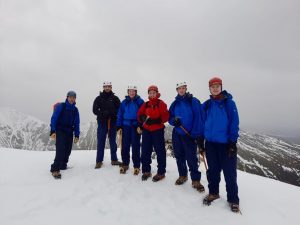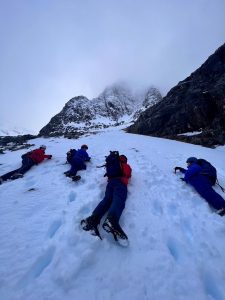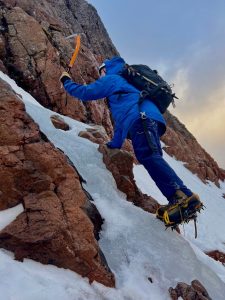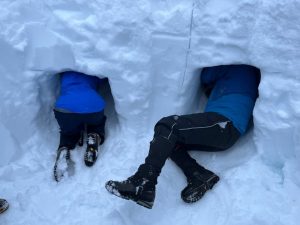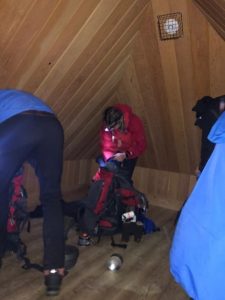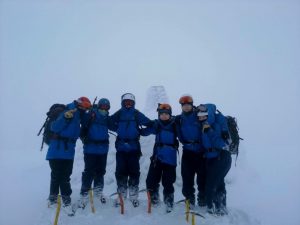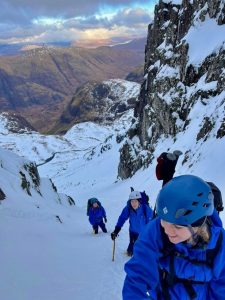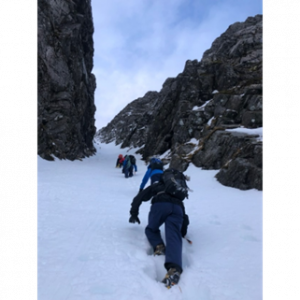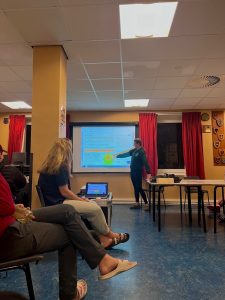On the 5th of January 2023, the Scottish mountains beckoned us. East Midlands University Officer Training Corps and one member from Birmingham Officer Training Corps set off on a 7-hour drive for the Scottish Highlands, with 21 Army Officer Cadets, 1 Regular Soldier, 1 Reserve Soldier, 4 Instructors and 1 Trainee Instructor and an Army Chef. Having arrived at the Kinlochleven, Glencoe, our base for the week, were issued a mammoth amount of kit to protect us from the weather conditions for the next 5 days. We had to have a mountain safety lecture highlighting all the hazards we may encounter during the week. The exposure to the mountain environment was beginning.
We split into 4 mixed ability groups and met our instructors. Each instructor gave us the opportunity to explore our own training aspirations. It was important to know what previous knowledge and experience some students had and what they wanted to gain from the week ahead. We enjoyed a hot meal after a long day prompting an early night for all ready for our first day of the Winter Mountaineering Foundation Course.
Day 1: This was the first day on the mountain and the first time for many on a Munro (a Scottish mountain over 3000 feet or 914.4metres) The main learning objective was understanding how to use the safety equipment such as crampons, ice axes and avalanche transceivers. The first day consisted of a journey to get our legs going and understand each team members’ abilities. We practiced movement with crampons, and ice axe arrests when climbing up the Scottish mountain Meall a Bhuiridh (1,108m) We employed along the way the clothing layering system enabling us to manage our body temperature when working hard, and when static to keep warm.
Day 2: Day two of the course, each group began to develop the basics they had learnt the previous day. For one group, they were tested on an ascent to the peak of Stob Ban (999m). A group practiced avalanche drills, enabling them to feel more confident in the case of an avalanche. Our group chose a challenging snow filled gulley to test our crampon work and ‘kicking steps’ into the snow. This was makes it easier for the rest of the group following to use the footholds. At the summit, the snow was thin and icy due to the wind, giving the perfect conditions to test our crampon work.
Day 3; One group set out for the summit of Stob Coire Nan Lochan (1,115m). The other groups chose a slightly shorter trek to further practice avalanche and transceiver training and furthering the understanding Avalanche rescue. It also allowed a leg rest in preparation for the great hike’s planned for the next day. Some groups located good snow and were able to build snow shelters, having had the lesson the night before. It became a competition between groups of who could build the best emergency snow hole in 20 minutes, the expected time you would have to create a shelter. The group dug deep into a snowbank, allowing enough room for themselves to sit sheltered from the external conditions. One group used this day to travel to the Cairngorms, visit the Commando Memorial at Lochaber, and complete an overnight expedition, staying the night in a bothy (a mountain hut you can sleep in for refuge). They used night navigation to reach the bothy, having set off at sunset. More mountain skills.
Day 4: Three out of four groups set off to complete their biggest mountain days yet, with two groups aiming to summit the highest peak in the UK, Ben Nevis (1,345m). One group managed the summit in full winter conditions. Another group had planned a different route and found it to be too dangerous due to the avalanche risk. We had learnt about making good decisions throughout the week and this was why! This was a valuable learning opportunity. The group managed to find an area of good snow and practiced some of their other newfound mountaineering skills. Another group travelled to the Glen Feshie in Cairngorm Mountain range and walked up Mullach Clach a’ Bhlair peak, in whiteout conditions! We had all learnt new skills and put them all into practice in a real environment. The final group went on their overnight expedition. They had a longer hike in, taking them to a Bothy where they spent the night sharing it with a pair of walkers with a dog and a New Zealander. They travelled by train and got off at the infamous ‘Trainspotting’ platform, before walking in the dusk to their overnight shelter. While this was the longest day for three of the four groups, it was the most rewarding, putting all our skills into practice and conquering some tough routes and conditions. The sense of achievement was huge.
Day 5: The final mountaineering day enabled each group to consolidate the weeks training and was generally an easier day of walking. Many groups were tired from the previous day’s expeditions. Groups practiced ice axe arrests, built snow holes, and practiced avalanche rescues. They used a buried transceiver in the snow to simulate a buried person and then located it using other transceivers. We then used avalanche probes to find a solid mass dug hard and fast with snow shovels we carried in our day sacks. One of the four groups managed to get one final peak, Beinn a’ Chaorainn (1,083m), which involved climbing a ridge, using ice axes and crampons. The route clearly matched the definition of Adventurous Training – controlled exposure to risk. On either side of the ridge was a steep rocky drop. On day 1 of the course this would have freaked us all out but by day 5 we had the skills, knowledge and confidence to tackle the ridge!
Each evening the students had a lecture which covered the course content and was the theory and explanations for what was taught on the hill the next day. Weather and avalanche reports was a key part of the training as it enabled us to plan ahead, pack the correct kit and select the safest routes. Towards the end of the week, many students had a go at presenting the weather brief for the whole group, which showed how much the students had learnt from the knowledgeable instructors.
Back at the hostel for the last night we returned all the kit we borrowed for the week, enjoyed Fajita night from Barry the chef, did some tidying up, had group debriefs and settled down for the evening. The next morning, we bundled into our minibuses and left Kinlochleven on a dreaded 7-hour journey back home. All mixed up we shared stories of our experiences from the week with the other groups.
The winter mountaineering foundation course has given us a fantastic introduction to the winter environment, conditions and skills required. We may not have had great views, but the resilience and determination we developed in these conditions are qualities we will carry for life. Many are us are now looking to gain quality mountain days to start the journey on the Mountain Leader training pathway.
One Officer cadet said ‘My favorite day was climbing the icy ridge on the final day. It put all our knowledge and skills to the test, from how to use ice axes and crampons, to what to wear for the conditions on the hill. I feel so fortunate to have been able to go on this course and would never have been able to learn the skills taught to me on this trip by myself. I feel so much more confident winter mountaineering, and it has inspired me to get more Quality Mountain Days to get on the next course!’.
As well as mountaineering skills, the course promoted personal development, both physical and emotional resilience, and has brought the unit closer together. The exercise allowed to create newfound friendships, and fantastic memories that will last a lifetime.
Ocdt Rickard and Russell
EMUOTC
EX DRAGON HIGHLAND EMU 23

